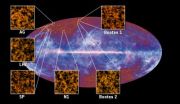(Press-News.org) BETHESDA, Md., Jan. 11, 2011 – An international team of researchers is reporting that it has uncovered new information about human papillomavirus that one day may aid in the development of drugs to eliminate the cervical-cancer-causing infection.
Led by researcher Per Jemth of Uppsala University in Sweden, the collaborators from four institutions detail in the Journal of Biological Chemistry how an offensive protein generated by the sexually transmitted virus handicaps a defensive protein made by the human body.
Co-author Neil Ferguson, a biophysicist at University College Dublin, says: "It has proved difficult to stem the proliferation of many viruses using conventional drug discovery. Inhibitors of protein-protein interactions, as in HPV's case, are potentially potent ways to perturb viral infections."
There are almost 200 strains of HPV, dozens of which are transmitted through genital contact, and about half of sexually active people have had one or more infections.
The immune system eliminates the virus within two years in about 90 percent of cases, according to the Centers for Disease Control and Prevention in Atlanta, but it lingers for many years in a minority of cases. Some strains result in no visible symptoms, others cause genital warts and still others cause cancer.
"Infection by high-risk human papillomaviruses is causing as many as half a million cases of cervical cancer and more than 200,000 deaths among women per year, making it one of the most common forms of cancer," Jemth emphasized.
For the virus to replicate, it has to interfere with the body's natural inclination to kill infected cells.
What is known as "programmed cell death," or the destruction of sick cells, ordinarily is carried out by several human proteins. However, when HPV is present, the virus sends out two of its own assassin proteins, known as E6 and E7, to stop the defensive human proteins in their tracks.
"Why is the virus causing cancer? In rare cases, the HPV infection is not cleared by the immune system and persists for decades. The virus' release of E6 and E7 proteins then increases the risk of deterioration to cancer by causing cell proliferation and preventing programmed cell death," explains Jemth. "If the cell dies, the virus will die along with it. So, the virus sends out these gunmen to assassinate proteins made by the body -- a hostile takeover, if you like."
In its study, Jemth's team offers a detailed look at how one human protein in particular, SAP97, is targeted by HPV assassin E6.
"To develop antivirals that prevent protein-protein interactions, in this case those of E6 and human proteins, it is necessary to first understand the biomolecular interactions required for virus viability and, where relevant, exploit these insights," says Ferguson.
So, the team used different techniques to visualize the attack – or, rather, how HPV's E6 and man's SAP97 bind to each other.
"We studied how fast E6 is latching onto SAP97, how fast it is coming off, how strongly it holds onto SAP97, and what happens to the shape of SAP97 as E6 is attached to it," says Celestine Chi, the first author of the paper.
It turns out that there are three places on SAP97 where HPV's E6 can latch on, he says, which bogs down the human protein so that it cannot carry out its normal function.
In fact, the team reports, three E6 molecules can attach to one SAP97 molecule simultaneously – essentially teaming up on the protein.
There currently are two vaccines that prevent HPV infection on the market, Cervarix and Gardasil, but they do nothing for those people who already are infected.
"Fundamental research on HPV is, therefore, still necessary to discover new routes to cure infection," Jemth says, which is why the team intends to continue its investigation and now has its crosshairs on HPV's E7 protein.
Ferguson adds: "The team's work represents an important step forward in understanding HPV biology and has important implications for therapeutic strategies. What was nice about this collaboration is that multiple laboratories worked synergistically such that the scope of the research and strength of the conclusions were significantly increased."
INFORMATION:
The team's research, funded by the Swedish Research Council and Science Foundation Ireland, was a collaboration of four universities -- Uppsala University and Linköping University in Sweden, University College Dublin in Ireland and University of Copenhagen in Denmark. The resulting "Paper of the Week" was published on the Journal of Biological Chemistry's website Nov. 27 and will appear in the Feb. 4 print issue.
Read the paper "Biophysical characterization of the complex between human papillomavirus E6 protein and synapse associated protein 97" at http://www.jbc.org/content/early/2010/11/27/jbc.M110.190264.
About the American Society for Biochemistry and Molecular Biology
The ASBMB is a nonprofit scientific and educational organization with more than 12,000 members worldwide. Most members teach and conduct research at colleges and universities. Others conduct research in various government laboratories, at nonprofit research institutions and in industry. The Society's student members attend undergraduate or graduate institutions. For more information about ASBMB, visit www.asbmb.org.
Study details how protein made by HPV teams up on and thwarts protective human protein
2011-01-12
ELSE PRESS RELEASES FROM THIS DATE:
Planck's new view of the cosmic theater
2011-01-12
VIDEO:
This animation illustrates the position on the sky of all compact sources detected by Planck during its first all-sky survey and listed in the Early Release Compact Source Catalogue (ERCSC)....
Click here for more information.
The first scientific results from ESA's Planck mission were released at a press briefing today in Paris. The findings focus on the coldest objects in the Universe, from within our Galaxy to the distant reaches of space.
If William Shakespeare ...
Planck space observatory releases first data
2011-01-12
The first scientific results from Europe's Planck spacecraft were released at a press briefing today in Paris. The findings, focusing on the coldest objects in the Universe - both within our galaxy and also out to the most distant reaches of space - include an exciting variety of astronomical finds, from massive galaxy clusters to new, unidentified objects. Planck is a flagship mission of the UK Space Agency, which funds the UK's involvement in both of Planck's scientific instruments. Astronomers from around the UK are now heavily involved in the operation of Planck's ...
Family, friends, social ties influence weight status in young adults
2011-01-12
PROVIDENCE, RI – Does obesity tend to "cluster" among young adults? And if so, what impact does it have on both their weight and weight-related behaviors? That's what researchers from The Miriam Hospital's Weight Control and Diabetes Research Center set out to answer to better understand how social influences affect both weight status and weight loss intentions in this difficult-to-reach age group.
According to the study, published online by the journal Obesity, overweight and obese young adults between the ages of 18 and 25 were more likely to have overweight romantic ...
Revealed: Secret businesses which aimed to exploit vaccine fears
2011-01-12
Andrew Wakefield, the disgraced doctor who claimed a link between MMR and autism, planned secret businesses intended to make huge sums of money, in Britain and America, from his now-discredited allegations.
The Wakefield scheme is exposed today in the second part of a BMJ series of special reports, "Secrets of the MMR scare", by investigative journalist Brian Deer. Last week we revealed the scientific fraud behind the appearance of a link between the vaccine and autism. Now Deer follows the money.
Drawing on investigations and documents obtained under the Freedom of ...
Common painkillers linked to increased risk of heart problems
2011-01-12
The drugs include traditional non-steroidal anti-inflammatory drugs (NSAIDS) as well as new generation anti-inflammatory drugs, known as COX-2 inhibitors.
The researchers say that doctors and patients need to be aware that prescription of any anti-inflammatory drug needs to take cardiovascular risk into account.
NSAIDs have been the cornerstone of managing pain in patients with osteoarthritis and other painful conditions. In 2004, the COX-2 inhibitor rofecoxib was withdrawn from the market after a trial found that the drug increased the risk of cardiovascular disease. ...
DNA blood test can cut invasive testing for Down's syndrome by 98 percent
2011-01-12
The blood test could mean that 98% of invasive procedures could be avoided, say the authors. The test uses the latest DNA technology to analyse genetic components in the mother's blood that indicate whether the foetus has Down's.
Down's syndrome or trisomy 21 occurs in around 1 in 800 births and older women are at higher risk.
Women in high risk groups tend to undergo a combination of scans and hormone level tests in order to determine if they need to have an invasive test such as amniocentesis or chorionic villus sampling. The latter tests take samples of genetic ...
Delivering a potent cancer drug with nanoparticles can lessen side effects
2011-01-12
Cambridge, MASS. -- Researchers at MIT and Brigham and Women's Hospital have shown that they can deliver the cancer drug cisplatin much more effectively and safely in a form that has been encapsulated in a nanoparticle targeted to prostate tumor cells and is activated once it reaches its target.
Using the new particles, the researchers were able to successfully shrink tumors in mice, using only one-third the amount of conventional cisplatin needed to achieve the same effect. That could help reduce cisplatin's potentially severe side effects, which include kidney damage ...
Call for full access to Tamiflu trial data to allow for independent scrutiny
2011-01-12
Tom Jefferson and colleagues from the Cochrane Group argue that the current system for assessing the safety and effectiveness of drugs, based on published trial data only, is "wholly inadequate" and "ethically dubious."
They propose a new approach that would allow in-depth scrutiny of the complete set of trial data for a new drug.
Their call comes after they reviewed the evidence for the antiviral drug oseltamivir (Tamiflu), and were unable to find sufficient published data to support the conclusion that oseltamivir reduces complications in healthy adults.
As a result, ...
Individuals with partial hearing loss may benefit from hybrid cochlear implant
2011-01-12
CHICAGO—Hearing loss can affect anyone, at any time. But it can be especially frightening for someone who suddenly starts to lose his hearing during adulthood. Tom Groves, 77, first noticed his diminishing hearing when he was in his early 40s. He was unable to hold conversations with large groups of people; found it nearly impossible to socialize in high-background noise environments like restaurants; and couldn't enjoy radio, TV and movies unless they were captioned. Now, Groves is hearing much better than he has in 30 years, thanks to an experimental hybrid cochlear implant. ...
Our perceptions of masculinity and femininity are swayed by our sense of touch
2011-01-12
Gender stereotypes suggest that men are usually tough and women are usually tender. A new study published in Psychological Science, a journal of the Association for Psychological Science, finds these stereotypes have some real bodily truth for our brains; when people look at a gender-neutral face, they are more likely to judge it as male if they're touching something hard and as female if they're touching something soft.
Several studies have found recently that we understand many concepts through our bodies. For example, weight conveys importance; just giving someone ...

